Types of House Plants
Are you constantly battling allergies or do you feel like you need to breathe new life into your home? Getting a houseplant might be the ideal solution for you. According to a study conducted by NASA, houseplants remove about 87% of toxins in the air in 24 hours. Houseplants also enhance the aesthetic appeal of your space.
We understand that choosing a houseplant for your home might be challenging. This is why we have covered different types of houseplants in this article to help you make an informed decision. Some plants need extra care while some don’t. Others might be toxic to animals and humans and you need to be extra cautious when handling them. Read on to learn more.
Tropical
Bromeliaceae, Parlor palm, Philodendron, Monstera, Anthurium, Peace lily, Rubber fig, Dumb cane, Broadleaf lady palm, etc
Flowering
Dracaena trifasciata, Zanzibar Gem, Spider plant, Devil’s ivy, Philodendron, Swiss cheese plant, etc.
Succulents
Jade, panda, snake, echeveria, string-of-pearls, cactus, aloe vera, agave, etc.
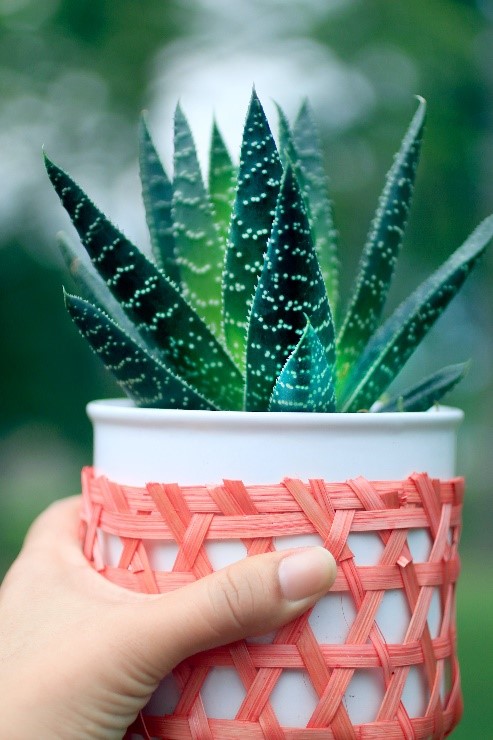
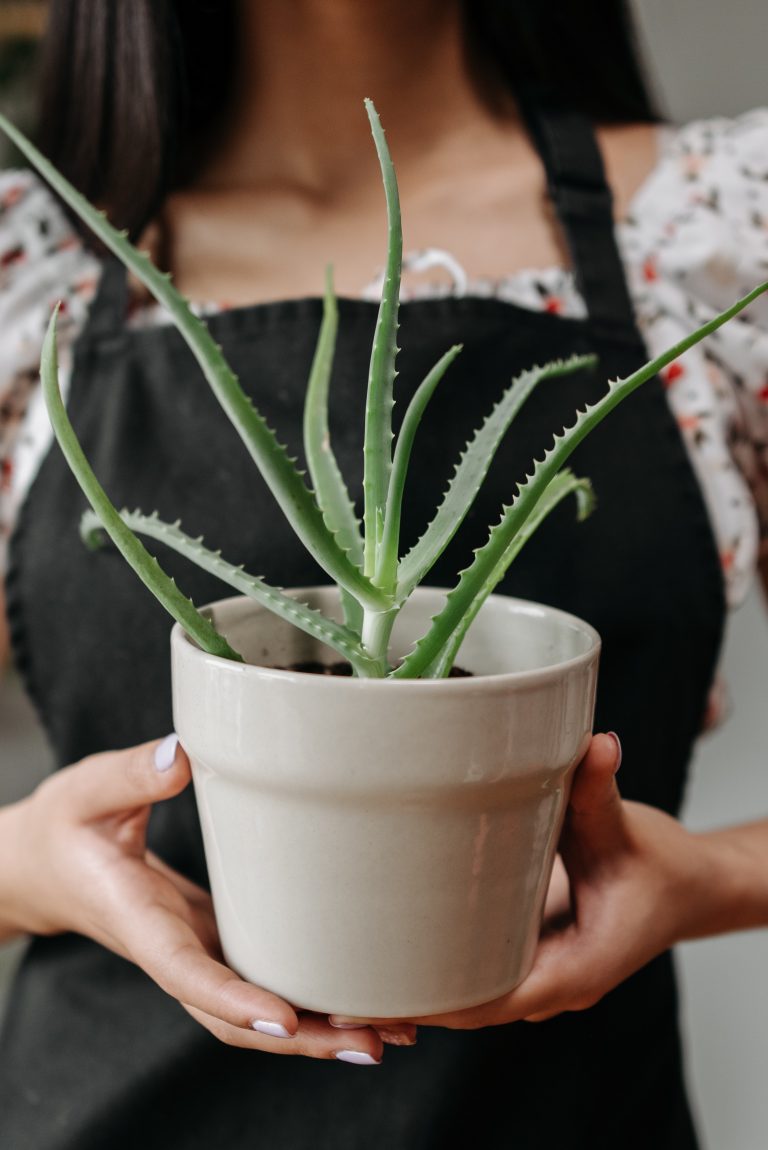
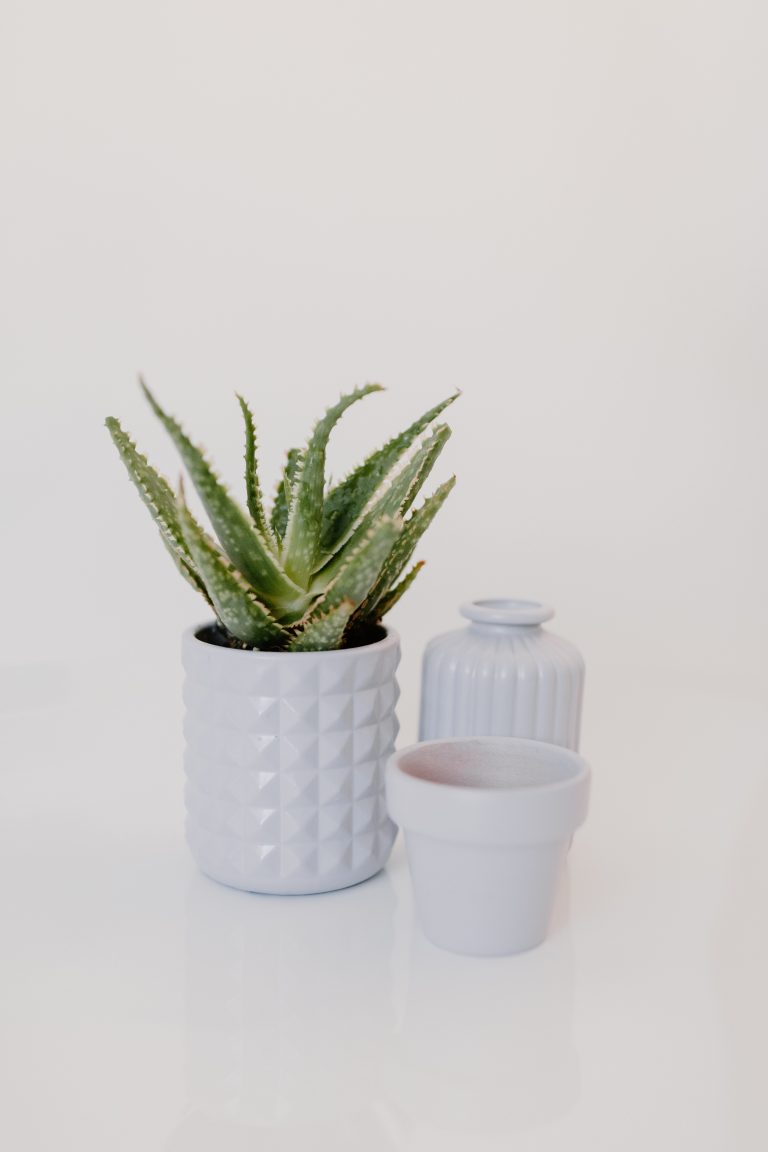
The Aloe Vera plant is one of the most common houseplants you can consider keeping in your home. This plant has succulent stems and a striking appearance that enhances the aesthetics of any space. Aloe Vera is also known for its health benefits. The plant has a gel-like substance used to soothe skin irritation like burns and wounds.
Apart from its health benefits, Aloe Vera is an ideal houseplant that is easy to maintain. The plant requires adequate lighting to grow. You can place the plant near a light source, preferably near a Southern-facing window. However, you should be careful not to over-expose your plant to extreme sunlight.
This plant does not need frequent watering but you can water your plant once every week when the soil dries out. Overwatering your plant might cause its roots to rot. Try to use soil that drains water quickly to prevent the plant’s roots from rotting.
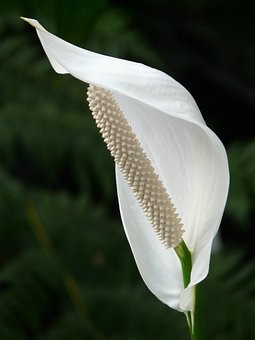
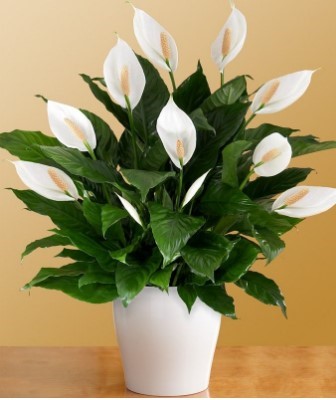
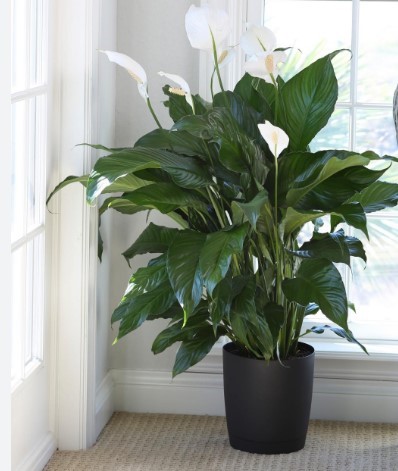
The Peace Lily is a popular houseplant with dark-green leaves and beautiful white flowers. The plant’s unique features will brighten up your home and make it stand out. The Peace Lily is easy to care for and maintain under the right conditions.
This plant thrives in low to medium-light conditions. Exposing your Peace Lily to moderate light will make its flowers bloom and enhance the aesthetics of your home. This plant also requires well-draining soil to prevent water retention. Too much water will cause the plant’s roots to start rotting.
Water your Peace Lily regularly but be careful not to overwater the plant. Ensure the soil has just enough moisture. Once the soil dries out, the plant’s leaves will begin to droop. This is a clear sign that your Peace Lily needs water.
Peace Lilies are also mildly toxic and can cause health issues when ingested. Keep the plant away from your children and pets to prevent accidents.
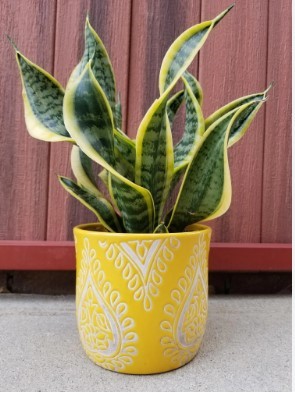
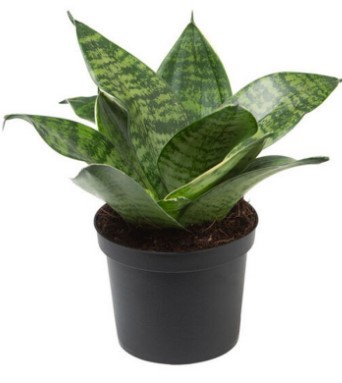
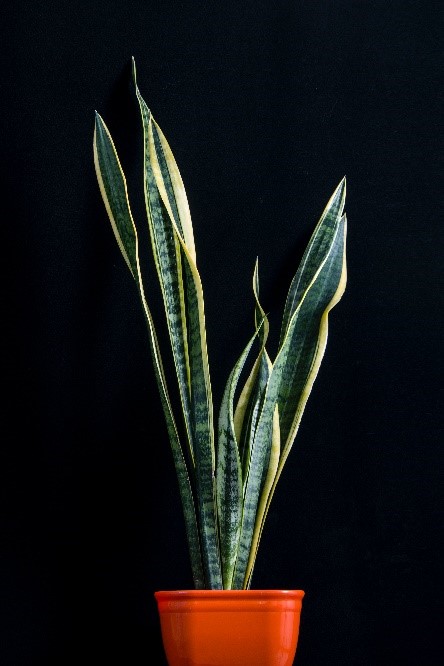
The Snake plant is a common succulent houseplant featuring upright green spiky leaves with striking grey-silver lines that make the plant stand out. This plant will add to the charm of your household and is relatively easy to care for. The plant also improves indoor air quality by getting rid of carbon dioxide.
There are various species of snake plants you can select from depending on your taste and style. Some of the common species include:
- Bird’s nest snake plant
- Twisted sister
- Cylinder snake plant
- White snake plant
What makes the Snake Plant stand out is its drought-resistant ability. This resilient plant can withstand dry conditions. You don’t need to water this plant frequently. Only water the snake plant when the soil is dry. Overwatering this plant will cause root rot which will eventually kill your plant.
Use soil that can drain water well preferably sandy soil. This plant grows well in warm temperatures and can tolerate bright to low levels of indirect sunlight. The Snake Plant can be poisonous when ingested. Keep the plant away from children and pets that might nibble on its leaves.
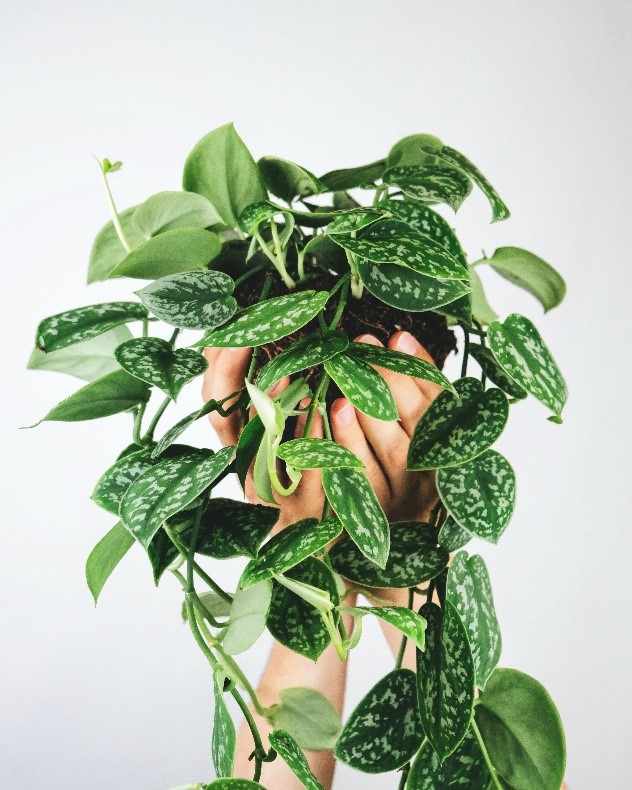

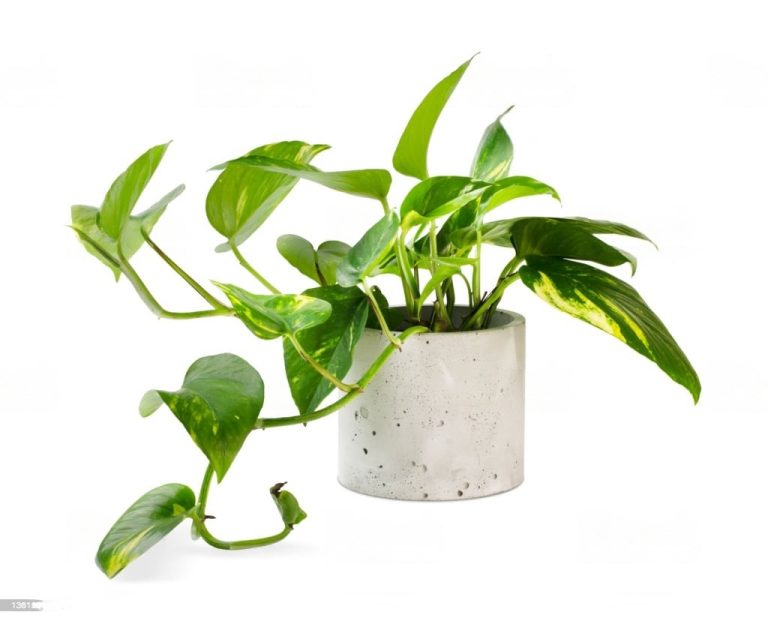
Pothos is an ideal houseplant you can select for your home. This plant has heart-shaped beautiful leaves that make the plant unique. Pothos is a climbing vine that brightens up your space. You can drape the plant across shelves or on your wall. However, you will need to prune the plant to prevent it from overgrowing.
This plant does well in bright indirect sunlight. However, the plant can also tolerate low levels of sunlight but it might lose its variegated color patterns under these conditions. The plant’s leaves will get burnt when exposed to direct bright light. Pothos requires well-draining soil to flourish. Too moist soil will cause root rotting.
Pothos does not require frequent watering and can withstand dry conditions. However, when the plant becomes too dry, its leaves begin to wilt. Water your plant only when the soil is dry. This plant contains poisonous substances and can be detrimental to your health. The plant is also poisonous to pets. To prevent accidents, you should keep it away from children or pets.
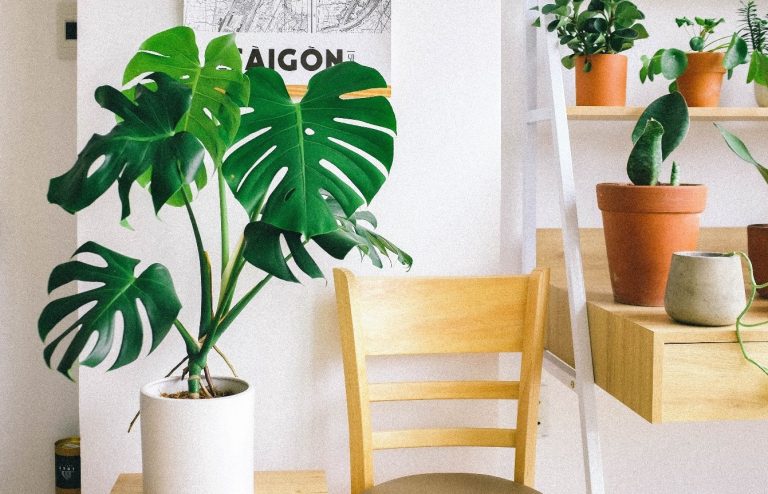
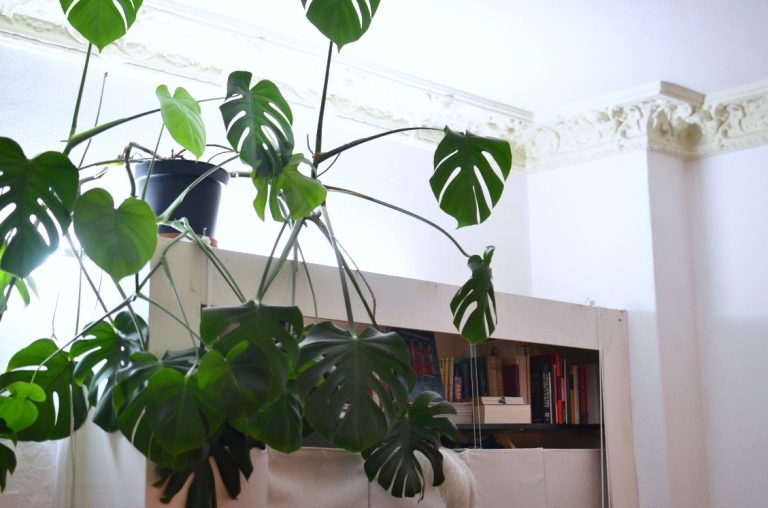
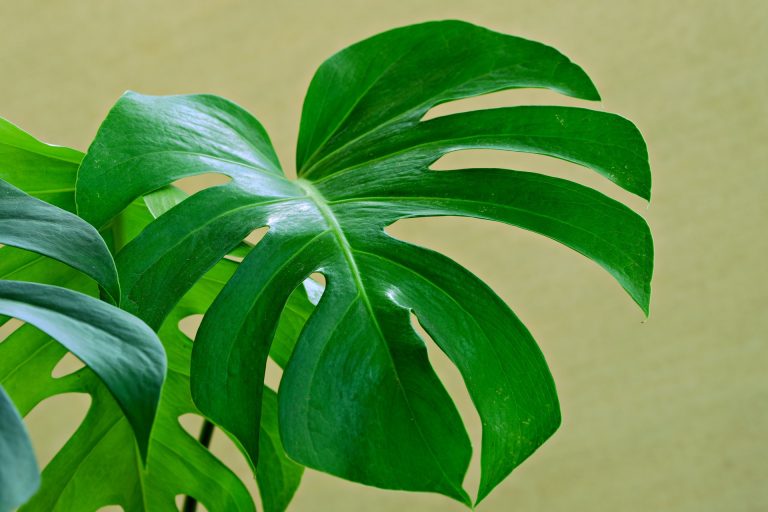
The Monstera plant is otherwise known as the Swiss Cheese Plant due to the holes in its leaves. This plant has a very unique look that adds a dramatic effect to your home. It is easy to take care of the Monstera plant as it requires little maintenance.
This plant will flourish in bright to medium sunlight levels. However, we don’t recommend exposing the Monstera to too much sunlight as its foliage will be scorched. The Monstera does well in high-drainage soil and doesn’t require frequent watering.
You should water your plant when your soil is dry. When exposed to too much sunlight, your plant might dry up quicker requiring you to water it more frequently. Yellow or wilting leaves indicate that your plant is drying up and it needs watering.
The Monstera produces fruit that is edible when ripe. However, the plant itself is toxic and poisonous when ingested. If you have pets or children in your household, you should consider placing the plant out of their reach.
Asparagus Fern (Asparagus aethiopicus)
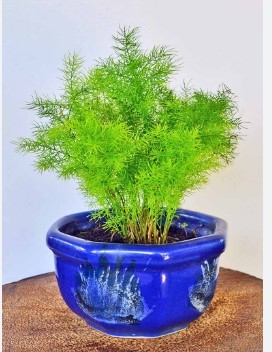
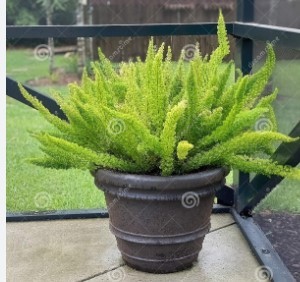

The Asparagus Fern is a commonly used houseplant with a feathery texture and an appearance resembling asparagus plants. However, the Asparagus fern is neither a fern nor an Asparagus plant. This plant thrives in warm humid areas and is an ideal choice if you want to enhance your home’s appeal.
The Asparagus Fern grows quickly and you will need to regularly trim your plant to keep it neat. The plant’s roots might also damage your pot and you should re-pot it after two years. The plant requires bright indirect sunlight to flourish. Exposing your Asparagus Fern to direct bright sunlight will scorch its leaves.
Plant your Asparagus fern in well-drained rich soil. This plant thrives in humid conditions and the indoor environment can be dry. Regularly mist your plant to maintain humid conditions. You should also water your Asparagus fern regularly, preferably when the soil is dry.
Droopy or brown leaves are a sign that your plant is dry. Don’t overwater your plant as it might cause its roots to rot. This plant is toxic and you should keep it away from pets and children.
Chinese Money Plant (Pilea peperomioides)
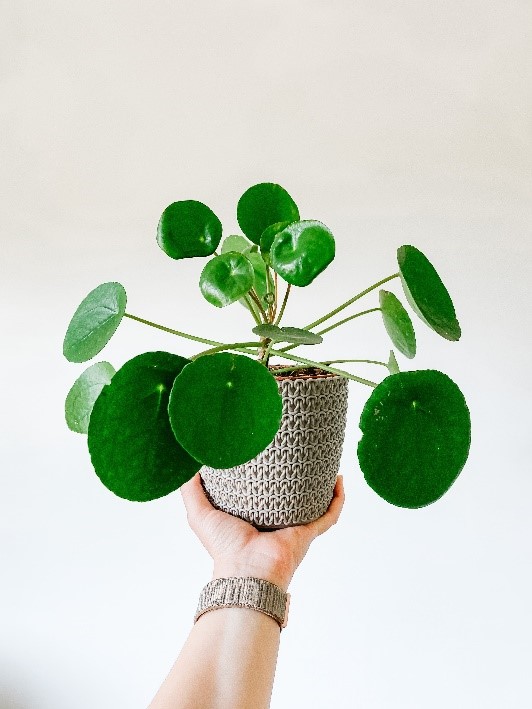
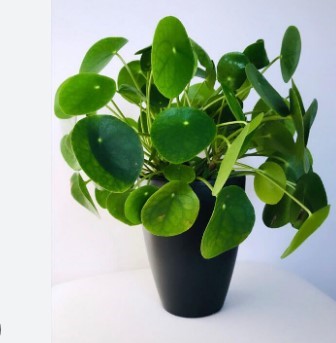
The Chinese Money Plant is a popular household plant with large circular pancake-shaped leaves that give it a unique appearance. This plant is also known as the coin plant, pancake plant, or UFO plant. The Chinese Money Plant is ideal if you want to transform your home into a vibrant and attractive space.
This plant originates from China and was believed to bring good luck and fortune hence its name. Its circular leaves also look like coins. This succulent plant is easy to maintain since it doesn’t require regular watering.
Its succulent nature makes it easily adaptable to dry conditions. However, you still need to water your plant once the soil becomes dry. When dry, the plant’s leaves will become droopy.
Plant your Chinese Money plant in a pot with drainage holes to prevent excessive moisture which might damage the plant’s roots. Ensure the soil is well-draining too. This plant thrives when exposed to sufficient lighting. Place your plant where there is bright indirect sunlight. Excessive sunlight will scorch the plant’s leaves. The Chinese Money plant will flourish and grow quickly when properly maintained. You can re-pot the plant annually.
Guiana Chestnut (Pachira Aquatica)
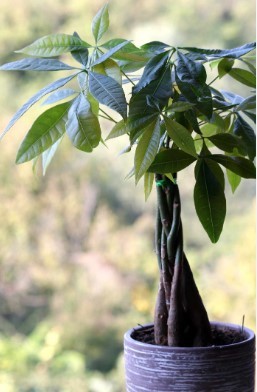
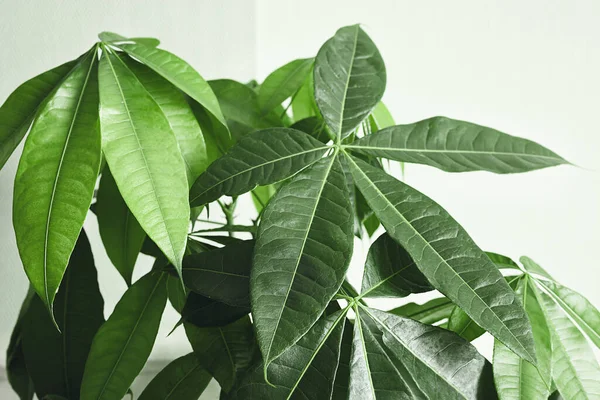
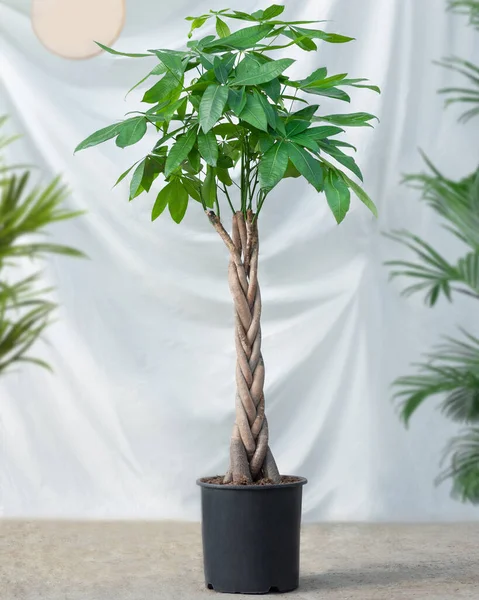
The Guiana Chestnut is otherwise known as the Money Tree and it features a unique braided stem with 5 leaves on each branch. Despite being a tree, this plant is commonly used as an indoor plant and grows between 6 and 8 feet tall.
The Money Tree flourishes when exposed to bright indirect sunlight. However, you should regularly rotate the plant since it tends to grow toward the light. Expose the plant to sufficient light for about 6 hours daily. The Guiana Chestnut can also thrive when exposed to fluorescent lighting.
This plant requires moderate temperatures and flourishes under high humidity conditions. Mist the plant regularly to keep the humidity levels high indoors. Fill a pebble tray with water and place your money tree on top of it to maintain humidity levels.
The Guiana Chestnut requires regular watering to grow properly. Water your plant when the first inch of the soil is dry. This plant can also withstand high moisture levels. However, you should be careful not to overwater your plant to prevent root rot. The following signs show inadequate watering of your plant.
- Yellow leaves
- Stunted growth
- Yellow spots
Air Plant (Tillandsia)
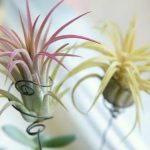
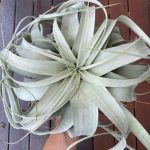
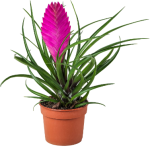
The air plant is a perennial plant that does not require soil to grow. Instead, the plant can be attached to other plants or a substrate. You can attach your plant to a piece of wood or hang it from a ceiling. This plant is one of the most low-maintenance houseplants you can consider.
Despite not requiring soil to grow, air plants still require nutrients. They absorb nutrients through their leaves. You can place air plants in a bowl or vase. Don’t place the plants in an enclosed container as they might rot due to inadequate air circulation.
Air plants will thrive when exposed to adequate lighting. Direct sunlight, however, can damage the plants’ leaves. These plants also need warm and humid conditions to thrive.
Watering an air plant is different from watering other plant types. However, the watering method you choose also depends on the type of air plant you have. You can soak air plants in a container filled with water for around 20 to 40 minutes after one or two weeks. Alternatively, you can mist the plant’s leaves regularly.
Bird’s Nest Fern (Asplenium nidus)
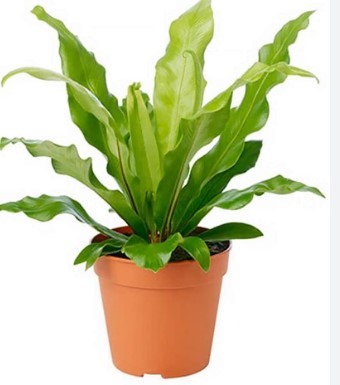
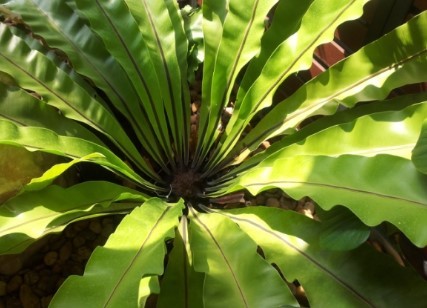
The Bird’s Nest Fern is another popular houseplant choice with long wavy light-green fronds that emerge from a single rosette. The Bird’s Nest Fern can grow up to 2 feet long indoors. The center of this plant looks like a bird’s nest hence its name.
This plant is one of a kind and enhances the aesthetic appeal of any space. The Bird’s Nest Fern thrives in warm and humid conditions. Keep the plant away from cool drafts and keep the conditions humid.
This plant requires medium to bright indirect lighting to grow properly. Exposure to direct light can scorch the plant’s leaves. The plant does well in rich soil with good drainage. Plant your Bird’s Nest Fern in a pot with drainage holes.
The Bird’s Nest requires frequent watering to stay healthy. However, overwatering the plant can cause its roots to rot. When watering this plant, don’t let the water get to the nest in the middle as the excess water could cause mold formation and rot. Re-pot your plant after every two to three years
Anthurium (Anthurium spp)


Anthurium is a unique household plant with beautiful glossy leaves and colorful spathes. The plant is otherwise known as the Flamingo Flower or Flamingo Lily. This plant has several shades of spathes including red, pink, orange, white, purple, etc.
Anthuriums will flourish when exposed to bright indirect sunlight. However, you should not expose these plants to direct sunlight to prevent scorching. You can alternatively use fluorescent lighting if you don’t have access to adequate natural light.
These plants also thrive well when planted in well-draining soil with organic matter. You can use an orchid mix with peat moss and sand to plant your Anthurium. Anthuriums require moist conditions to survive. Don’t let the soil dry out. When the top layer of the soil becomes dry, water your plant.
However, you should not overwater your Anthurium. Too much moisture can damage the plant’s roots. Water your plant at least twice per week during the dry season and once per week during the cold season.
An Anthurium requires high humidity to thrive. You can mist your plant daily to maintain humid conditions. Alternatively, you can add water to a tray that has pebbles in it and place your Anthurium on top of the tray to keep the plant moist. This plant is poisonous when ingested. You should keep your Anthurium away from pets and children.
Begonia (Begonia spp)
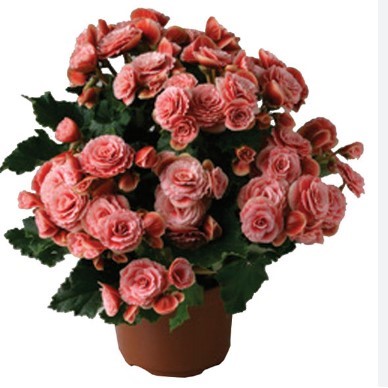
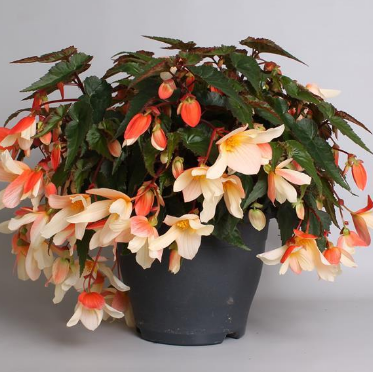
If you want to brighten up your space, planting a Begonia would be an ideal solution. Begonias are beautiful indoor plants with bright flowers. The leaves of a Begonia feature eye-catching patterns that add a bold and dramatic effect to your home.
You can choose an appropriate species from the multiple Begonia species available. Begonia flowers are available in a wide array of colors including white, pink, yellow, orange, and red. The following are some types of Begonia plants.
- Wax Begonias – These plants are also known as fibrous-rooted Begonias. They feature round waxy leaves hence their name.
- Tuberous Begonias – These plants are known for their attractive flowers and foliage. They have tuberous roots and you can use them in hanging baskets.
- Cane Begonias – These plants tend to grow upright and have segmented stems. They have attractive flowers and foliage.
- Rhizomatous Begonias – These plants grow from rhizomes that grow horizontally. They are popular for their striking foliage and blooms.
Begonias require bright to medium indirect sunlight to flourish. Some varieties will become scorched when exposed to direct sunlight. Other varieties of Begonia plants require shade to thrive.
These plants are prone to root rot when exposed to too much moisture. Therefore, you should plant your Begonia in a well-draining pot. You can use sandy soil and compost to improve the drainage of your soil.
Water your plant regularly and ensure your soil doesn’t completely dry out. Be careful not to overwater your plant to prevent root rot. Water the soil directly and avoid watering the plant’s foliage to prevent diseases such as powdery mildew.
Begonias are tropical plants and require high humidity levels. When choosing a location for your Begonia, ensure there it has enough humidity to sustain the plant. The plant is toxic to pets such as dogs, cats, and horses. It would be best to place your plant where your pets cannot access it.

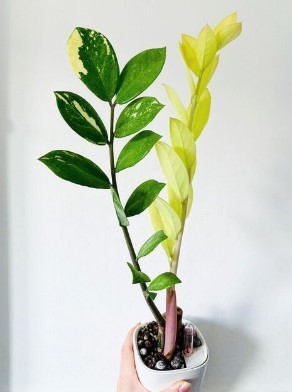
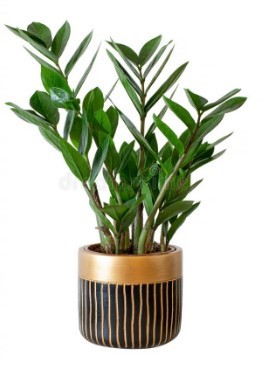
This plant is one of the most resilient indoor houseplants that require little maintenance. The ZZ plant is also ideal if you want to enhance your indoor air quality. This plant features broad dark-green glossy leaves that improve the aesthetics of any space it occupies. The ZZ plant is often mistaken as an artificial plant due to its shiny unique leaves.
The ZZ plant is drought resistant and can withstand dry conditions. However, you should water your plant when the soil dries out completely. Try to water the plant at least once every two weeks. Don’t overwater the plant to prevent root rot. You can plant your ZZ plant in a well-draining pot with sandy soil.
This plant thrives when exposed to indirect sunlight. However, this plant can tolerate medium to low levels of sunlight. Your plant will become stretchy under low light conditions. Try not to expose it to direct intense sunlight to prevent scorching.
A ZZ plant can tolerate average levels of humidity and temperatures. You need not worry about keeping humidity levels up. However, you should be cautious when purchasing this plant as it is poisonous both to pets and humans. Place it out of reach to prevent accidents.
ZZ plants can also become dusty which could affect their appearance and health. You can wipe your plant occasionally with a damp cloth. Try to also cut off damaged leaves to keep your plant neat.
Cast Iron Plant (Aspidistra elatior)
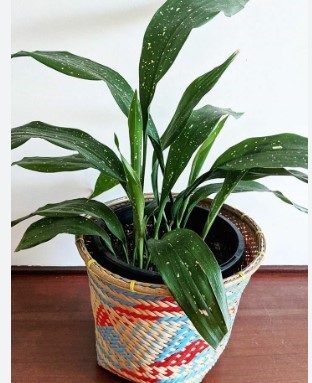
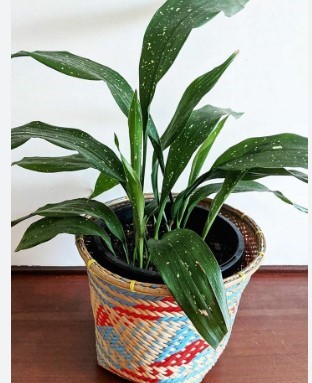
As its name suggests, this plant is quite resilient and can withstand tough conditions. The Cast Iron plant would be a suitable choice if you are looking for a low-maintenance indestructible houseplant. This plant can survive conditions that other plants can’t survive. The Cast Iron plant features large green shiny foliage.
This plant enhances indoor air quality and reduces allergens. There are different varieties of Cast Iron plants you can choose from including:
- Asahi Cast Iron Plant – This plant has large glossy leaves with beautiful white strips at their tips.
- Hoshi Zora Cast Iron Plant – This plant features white specks mimicking a starry appearance.
- Variegata Cast Iron Plant – This plant has long broad green leaves with vertical white-cream streaks.
The Cast Iron plant flourishes in indirect bright sunlight. However, the plant can still survive when exposed to low levels of sunlight. Avoid placing your plant in direct sunlight as its leaves will bleach. This plant prefers well-draining soil as it doesn’t require a lot of moisture.
Your Cast Iron plant won’t require frequent watering. However, you will require to water it when the soil becomes dry. Overwatering your plant will make the soil soggy and lead to root rot which will damage your plant. This plant requires moderate humidity levels to grow and temperatures between 45 and 60 degrees. Extreme cold conditions can damage your Cast Iron plant.
Banana Plant (Musa spp)
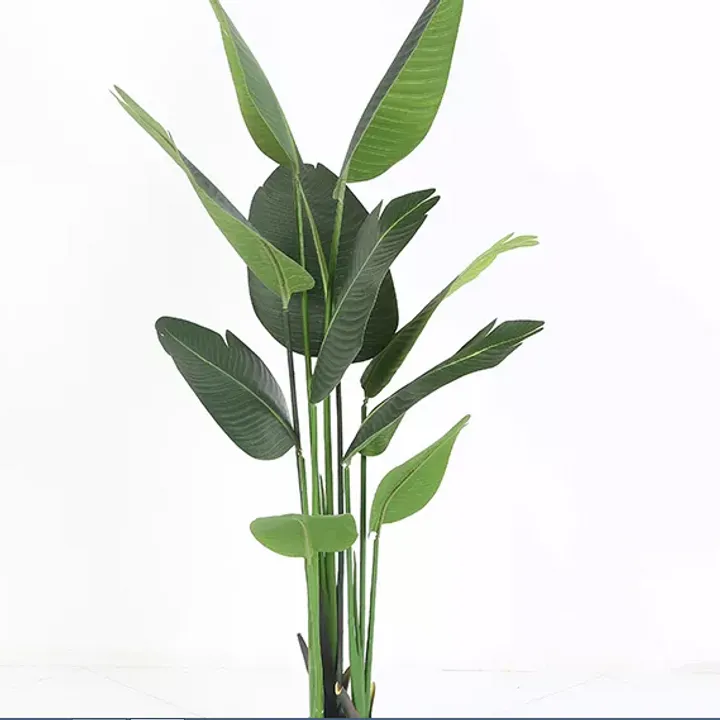
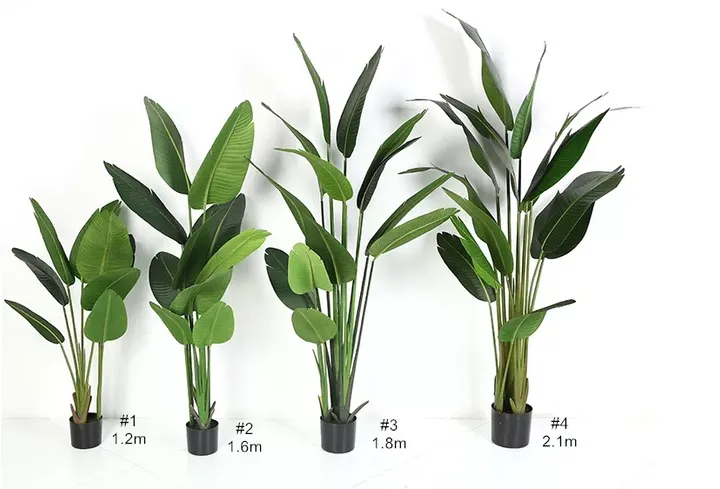
Not only are banana plants grown outside for their fruits but also indoors as ornamental plants. If you want to achieve a tropical vibe in your home, a banana plant would be the ideal choice.
The plant has wide shiny leaves attached to a wide fleshy stem. You will need to have a lot of room in your house since this plant grows quickly. You can opt for dwarf varieties to prevent overgrowth.
You will require a large pot with excellent drainage to support the plant’s roots. Use a fresh potting mix to plant your banana plant. Ensure your soil has lots of organic matter to help the plant flourish. Your banana plant will thrive in a slightly acidic soil mixture.
The banana plant needs consistent watering to thrive. Don’t let the soil dry out completely. Try to be cautious not to overwater your plant. The banana plant requires plenty of light to grow. Place your banana plant where it can get lots of bright light. You can occasionally place it outdoors to get maximum lighting.
Your banana plant will require warm temperatures and high humidity levels to flourish. Try to mist the banana leaves often to maintain high humidity levels. You can also place your pot on a humidity tray. Avoid placing your banana plant in drafty locations or near air vents. The banana plant is not toxic and you don’t have to worry about keeping pets and children in the same environment as the plant.
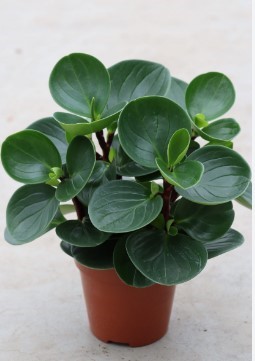
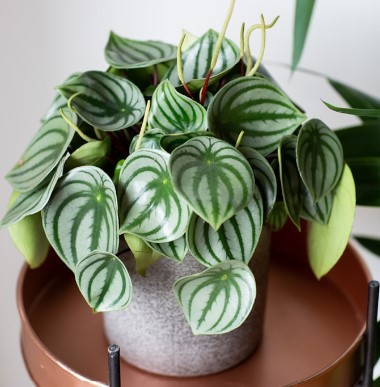
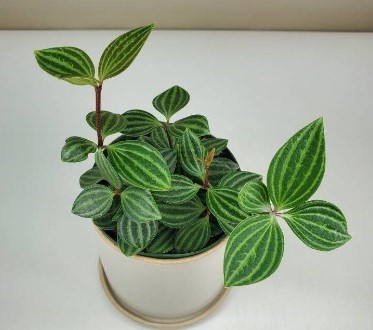
Peperomia is a tropical houseplant that is available in a wide array of colors and sizes. The plant has round fleshy leaves with a variety of patterns. The plant features ornamental leaves making it an ideal choice if you want to enhance the beauty of your home.
Peperomia can have either smooth or textured leaves available in green, purple, red, or green hues. You can choose a suitable plant that fits your home’s style and décor. This plant is low maintenance and would be a great choice if you are a beginner. Peperomia would also be ideal if you don’t have a large space as it does not grow too tall.
The plant’s succulent or semi-succulent nature makes it drought-resistant. Therefore, you don’t have to frequently water your plant. Rather, you can wait till the soil is almost dry and water your Peperomia. Avoid overwatering as it could lead to root rot which will kill your plant.
Your plant needs bright indirect light to thrive. Alternatively, you can use fluorescent lights if you don’t have access to bright natural light. Low light levels will make your plant begin to look leggy and unhealthy. The plant might also start to shed its leaves to conserve energy. Exposure to direct sunlight will scorch the plant’s leaves.
A Peperomia plant requires warm temperatures and high humidity levels to thrive. You can frequently mist your plant’s leaves in the morning to maintain high humidity levels. You can also use a humidifier or a humidity tray to maintain humidity levels. Plant your soil in well-draining soil preferably a loose soil mixture.
English Ivy (Hedera helix)
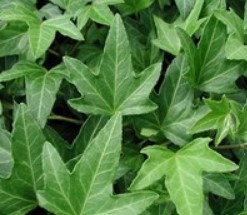
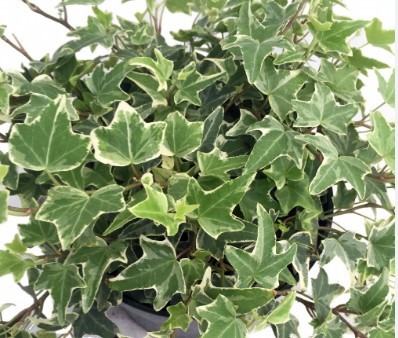
The English Ivy plant is a common houseplant with a trailing growth form that makes it stand out. The plant can climb on your walls enhancing the aesthetic appeal of your home. You can alternatively use the plant in hanging baskets and let the plant trail down the edges of your pot or shelves. However, this plant grows quickly and can be invasive. You should regularly prune your plant to prevent structural damage.
This plant requires regular watering remain healthy. Water your English Ivy when the soil is almost dry. Your soil should be moist but not soggy. Wet soil will cause root rot which will eventually kill your plant. Use a pot with drainage holes to prevent water retention. The plant does well in a loose organic potting mix.
The English Ivy flourishes under bright to medium sunlight conditions. You can place your plant in a Southern-facing window to provide enough lighting. Moderate humidity is fine for an English Ivy. You can use a humidifier to set the humidity levels right. The plant will also thrive in moderate temperatures.
Re-pot your English Ivy every one to two years. When repotting your plant, use fresh soil to ensure your English Ivy gets maximum nutrients. This plant is toxic to cats and dogs. If you have pets, keep your English Ivy away from them.
Christmas Cactus (Schlumbergera spp)
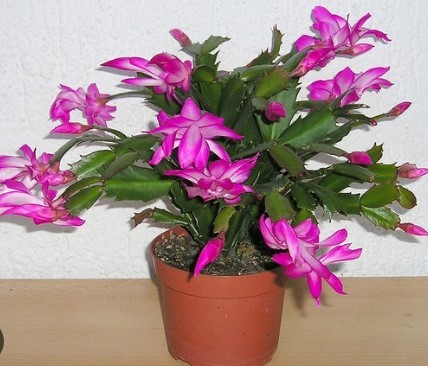
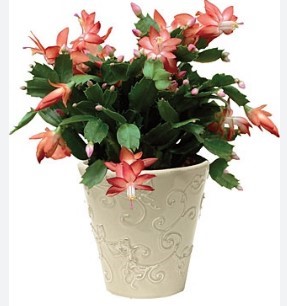

The Christmas Cactus is popular for its attractive flowers available in yellow, pink, apricot, red, and other hues. It is definitely an ideal choice if you want to brighten up your space during the holidays. You can also gift this beautiful plant to your loved ones during the gifting season.
However, unlike other cacti plants, the Christmas Cactus is not drought-resistant and it needs regular watering to remain healthy. Don’t let the soil dry out completely before watering your plant. Dry conditions will make the plant’s leaves shrivel.
You can water your plant about thrice weekly. Ensure your pot has excellent draining to prevent moisture retention. Use regular potting soil to plant your Christmas Cactus. The Christmas Cactus will thrive when exposed to medium or bright indirect sunlight. Low levels of light will affect your plant’s health.
Direct exposure to sunlight might burn the plant’s foliage. Therefore, striking a balance is necessary to maintain the plant’s health. This plant needs moderate humidity levels. Regularly mist your Christmas Cactus to maintain moderate humidity levels. You can alternatively use a humidifier or a humidity tray.
This plant needs varying temperatures. For growth, the plant requires temperatures ranging from 70 to 80 degrees. For bud formation, the Christmas Cactus requires temperatures ranging from 55 to 65 degrees. Keep your plant away from drafty doors or windows that might affect your plant negatively.
Prune your Christmas Cactus to make it neat and encourage growth. You can prune your plant right after it blooms because this is when it is more likely to grow. We recommend re-potting your Christmas Cactus after 3 or 4 years. The Christmas Cactus is non-toxic and you can rest assured that your pets will be safe around it.
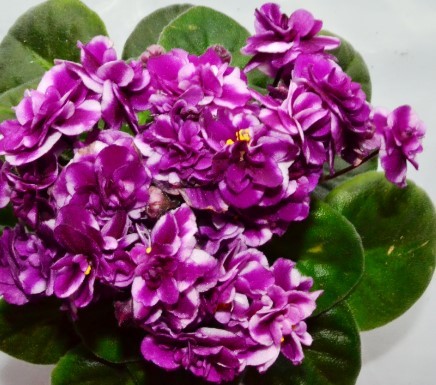
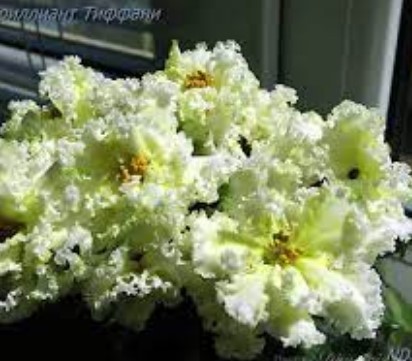
The African Violet is a popular houseplant known for its attractive violet-colored flowers and lush green leaves. This plant is native to East Africa and was discovered by Walter von Saint Paul-Illaire hence the name Saintpaulia.
However, the plant’s name has since changed to Streptocarpus. African Violets are not true violets but rather get their name from their violet-colored flowers.
For this plant to flourish, you will need to take care of it. The plant requires medium to bright indirect light to thrive. You can also use artificial light if you can’t access natural lighting. Too much light will scorch the plant while too little light will make your plant stretch. Just make sure your plant is exposed to enough light.
This plant requires regular watering to stay healthy. Keep the soil moist but not too wet. Overwatering the plant will cause its roots to rot. The plant requires lukewarm water. Water the plant at its base directly to the soil. watering its foliage will cause damage.
Plant your African Violet in a well-draining soil mixture preferably a regular potting mix. African Violets flourish in warm and humid conditions. To maintain high humidity levels, you can use a humidity tray (a pebble tray with water). We don’t recommend misting the plant’s foliage as you might damage its leaves. Prune damaged and excess leaves to maintain your plant’s appearance.
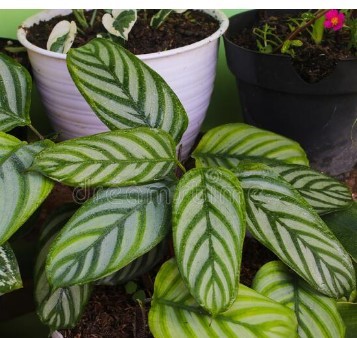
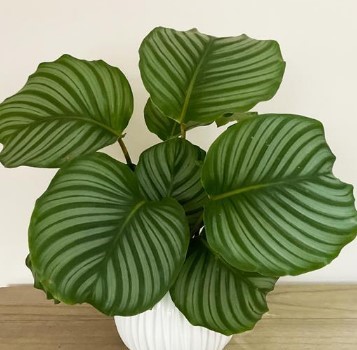
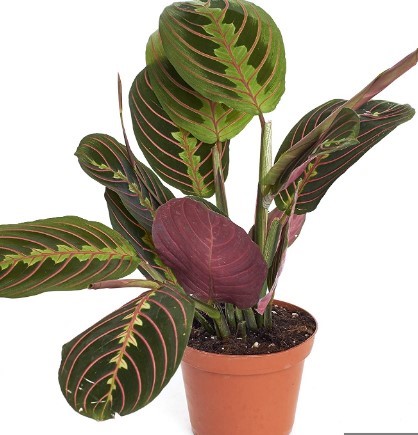
The Calathea plant is a common houseplant otherwise known as the Zebra plant, Rattlesnake plant, Peacock plant, among others. The plant features attractive leaves with the most striking patterns. A Calathea plant makes a bold statement in any space, enhancing the aesthetic appeal of your household.
This plant requires extra care but it is worth the effort. The Calathea plant is also pet-friendly making it an ideal choice if you keep pets in your home. The plant comes in a variety of colors and patterns you can choose from depending on your taste and style.
Calatheas require mild to low indirect sunlight levels to thrive. Exposure to bright direct sunlight will scorch the plant’s foliage. Constantly rotate your plant to maximize sunlight exposure. You can alternatively use artificial light if you can’t access sunlight.
Regularly water your Calathea plant to maintain its health. You can let the top layer of soil dry up before watering your plant again. Doing so will prevent overwatering which might cause root rot. Keep the soil moist but well-drained. One sign of an under-watered Calathea is curling leaves. Once you notice the plant’s leaves are curling, it might be the ideal time to water it.
Calathea is a tropical plant and it prefers warm humid conditions. Regularly mist your plant to keep the humidity levels up or use a humidifier. Keep your plant away from drafty windows, doors, and air vents. Your Calathea plant will be fine under room temperature conditions. Fertilizing your plant will promote more growth and keep the plant healthy.
African Mask (Alocasia)

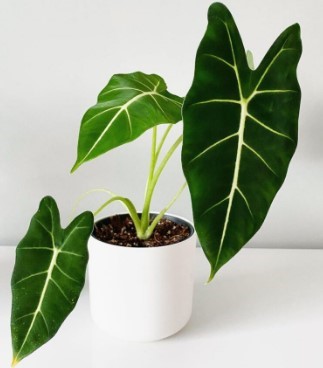
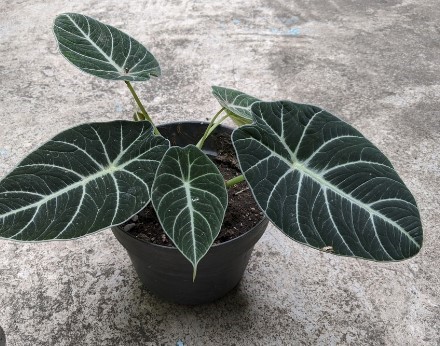
The African Mask plant otherwise known as Elephant Ears is a popular household plant. What makes this plant stand out is its large arrowhead-shaped leaves with contrasting patterns. The plant gets its name from its resemblance to literal African masks and not because the plant is native to Africa. The African Mask plant originates from Philippine Islands.
If you are looking for an ornamental and unique houseplant, African Mask would be an ideal choice. However, you will need to take good care of the plant to maintain its appearance and health. The plant is also toxic to humans and animals when ingested. Therefore, you should take extra precautions if there are any pets and children in your home.
This plant flourishes with regular watering. Check the top layer of the soil to discover when to water your plant. If the top layer of the soil feels dry, water your African Mask. Be careful not to overwater your plant to prevent root rot. Plant your African Mask in well-aerated and drained soil. you can use a potting mix, peat, and perlite.
The African Mask plant thrives when exposed to indirect bright or moderate light. Constantly dust your plant to maximize light absorption. Your plant’s foliage will be burnt when exposed to direct sunlight. The plant also needs high humidity levels and warm temperatures to flourish. Use a pebble tray or humidifier to maintain humidity levels.
Misting the plant might lead to fungal infections. Place your plant away from drafts and air vents to keep it warm. You can prune old leaves to preserve the appearance of your plant.
Donkey’s Tail (Sedum morganianum)

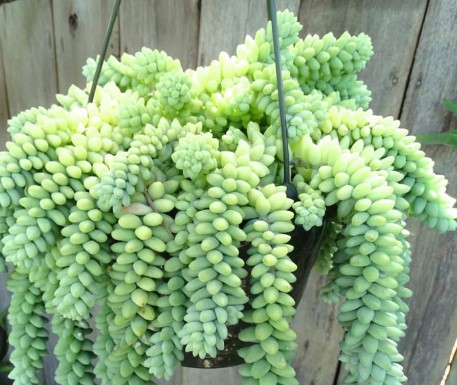
Donkey’s tail is a distinctive trailing houseplant that has plump succulent leaves that form a cluster. Its leaves are greenish-bluish and pointy. The plant is also known as Burro’s tail, or Lamb’s tail. A Donkey’s tail plant can grow up to 4 feet long. The plant is ideal for hanging baskets and will enhance the aesthetic appeal of your home. This plant sometimes produces pink flowers but it rarely blooms indoors.
The Donkey’s Tail plant requires regular maintenance to remain healthy. Its leaves require extra care as they might fall off when touched. Therefore, you should avoid constantly moving your plant. You can place it in an ideal position, preferably near a window, and avoid regular contact.
This plant requires well-draining soil to flourish. You can use a sandy soil mixture and a pot with drainage holes at the bottom. Unlike other resilient succulents, this plant needs frequent watering to flourish. However, the Donkey’s Tail is a succulent and cannot tolerate overwatering.
The plant’s roots will rot when overwatered. You should let the soil dry out completely before watering your Donkey’s Tail. you can water your plant every two to three weeks depending on the season. The plant will require more water in the summer and less during winter.
The Donkey’s Tail plant needs medium to bright indirect lighting to thrive. You can place your plant near a window to maximize light exposure. The Donkey’s tail cannot tolerate bright direct light and its leaves will be scorched.
The plant prefers warm temperatures to flourish. Temperatures between 65 and 75 degrees are okay. This plant requires average humidity levels to survive. You don’t need to mist the plant or use a humidifier.
Moth Orchid (Phalaenopsis)
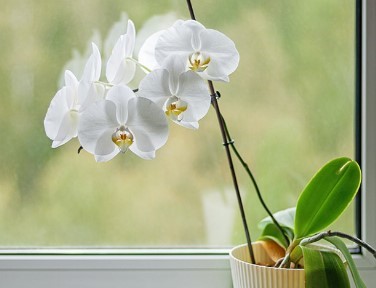
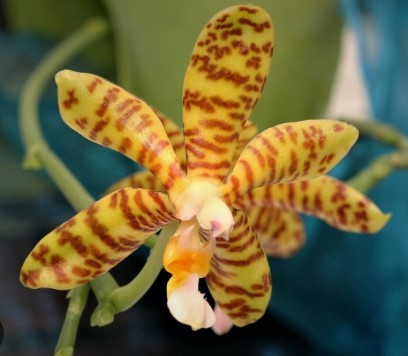
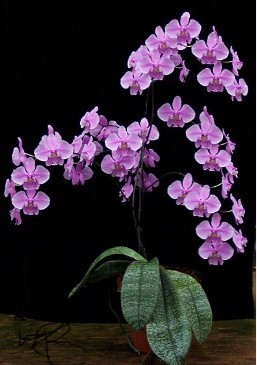
The Moth Orchid is a popular houseplant that originates from Asia. What makes this plant stand out is its beautiful foliage and eye-catching blooms. Its flowers will add color to your home and make it look lively.
The Moth Orchid produces flowers in hues of pink, white, purple, and others. These plants are relatively easy to grow and maintain. If you are purchasing your first houseplant, you could consider choosing a moth orchid to brighten up your home.
The Moth Orchid plant has coarse thick roots that don’t require soil to grow. They often grow on tree bark outside. To mimic these conditions, you can pot your houseplant using bark.
This plant needs medium to bright indirect sunlight to remain healthy. Low levels of light turn the plant’s leaves dark green. Too much exposure to direct light will scorch the Moth Orchid’s leaves. You can alternatively use fluorescent lights if you don’t have access to natural light.
This plant needs frequent watering to survive. Water your Moth Orchid when the bark is completely dry. You might notice that the plant’s roots turn grey when dry and light green when watered. Be cautious not to overwater your plant as its roots will rot.
Feed your plant regularly with orchid fertilizer to maintain its health and promote growth. Pruning your Moth Orchid regularly will also promote growth and improve its appearance. Get rid of brown leaves and cut down unhealthy roots.
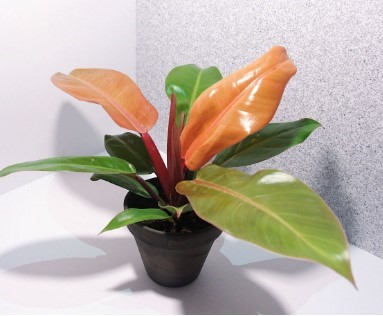
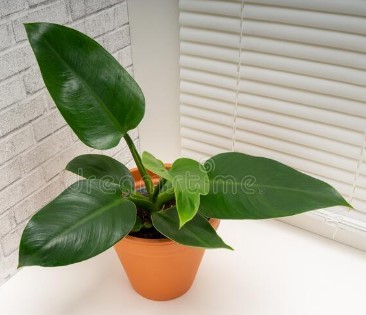
Philodendron is a common household plant that stands out due to its attractive foliage. The plant has large shiny heart-shaped leaves that will enhance your home’s décor. A Philodendron is also quite easy to maintain and would be suitable for beginners. You can choose from the climbing and trailing varieties. A trailing Philodendron will look great on a hanging basket, or on your wall. An upright Philodendron is equally attractive but it might grow slowly.
This plant is a great air purifier and you can use it to improve your indoor air quality. However, this plant is toxic to both animals and humans. Keeping children and pets around the plant wouldn’t be a good idea. While a Philodendron is a low-maintenance plant, it still requires some care to thrive.
A Philodendron requires filtered light to thrive. You can place your plant near a window to expose it to bright indirect sunlight. Too little light will affect the plant’s growth making it stretchy. Direct exposure to bright light will scorch the plant’s leaves.
This plant will flourish with moderate watering. You can water your plant when the top inch of the soil becomes dry. Overwatering your Philodendron will lead to root rot. When under-watered, the plant will begin to droop. Plant your Philodendron in well-draining loose soil. Use a pot with draining holes to get rid of excess water.
A Philodendron will survive under room temperature conditions. However, temperatures below 55% are not suitable for the plant. Keep your plant away from drafty windows or doors. This plant also prefers high humidity levels.
You can mist your plant regularly to keep humidity levels high or use a humidity tray. Since Philodendron vines can overgrow, you can prune the plant regularly to maintain its appearance and get rid of unhealthy leaves.

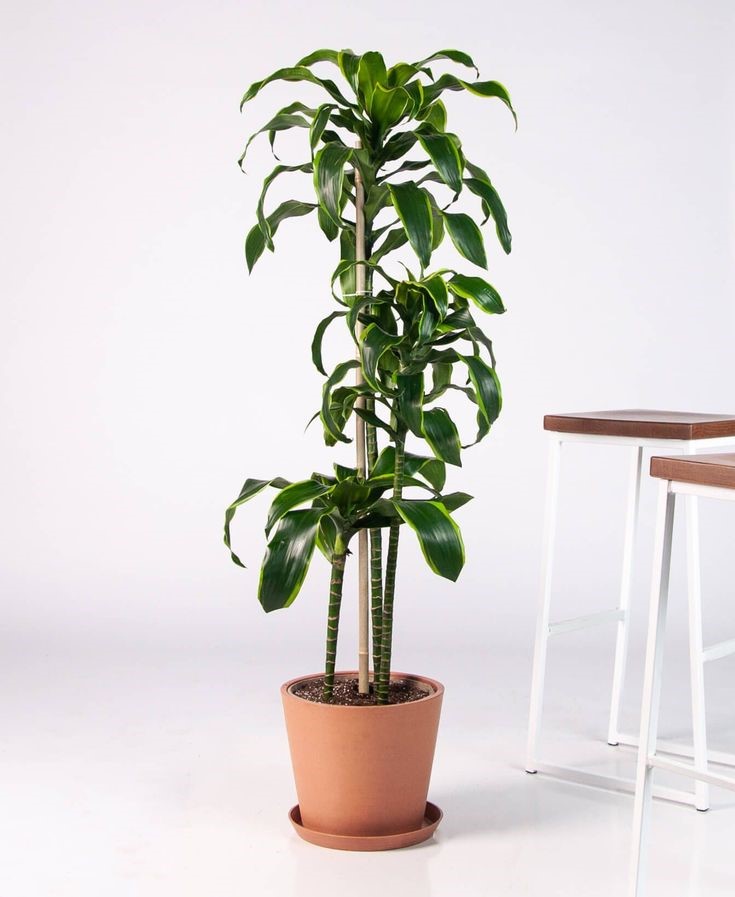
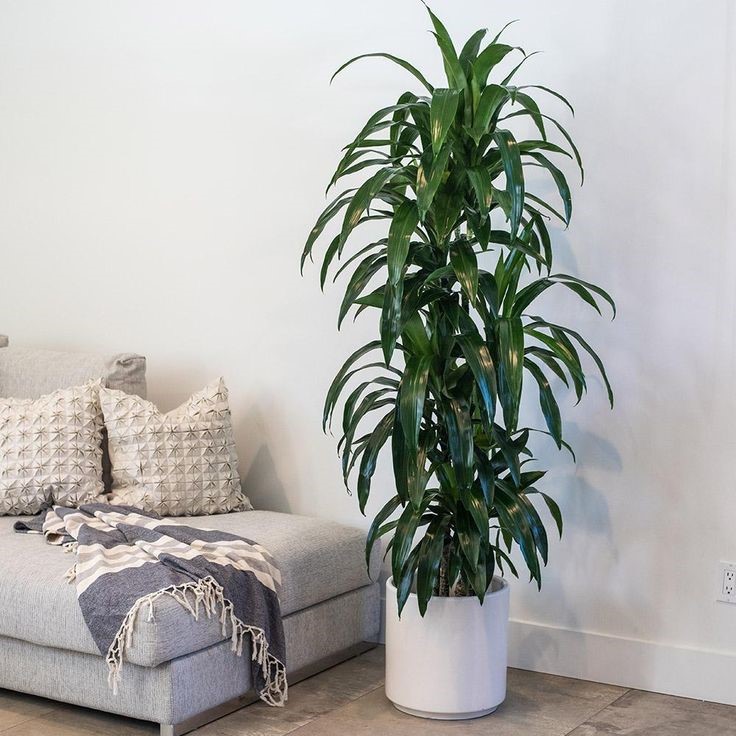
The Dragon Tree is a popular household plant with attractive spiky leaves and a sturdy stem. The plant is otherwise known as the Red-edge Dracaena or the Madagascar Dragon Tree. This plant is an ideal choice if you are looking for a low-maintenance plant with aesthetic qualities.
This plant is drought-resistant and resilient making it easy to take care of. However, the Dragon Tree is toxic to animals and you should keep it away from pets who love nibbling.
As an indoor plant, the Dragon tree can grow up to 6 feet tall. This plant also purifies indoor air and gets rid of toxins. The Dragon Tree requires bright to medium indirect light to flourish. Be sure to place your plant in a position where it will get adequate lighting. Little light will affect the growth of your Dragon Tree making it produce smaller leaves. Too much light will scorch the plant’s foliage.
The Dragon Tree is drought-resistant and doesn’t need regular watering. Only water your plant when the top half of the soil is dry. This plant does not tolerate overwatering and will die when overwatered. To ensure you don’t overwater your plant, use well-draining loose potting soil.
The Dragon Tree develops brown or yellow leaves when dry. Although brown leaves can also indicate too much salt or fluoride. Consider using distilled water to prevent brown tips. Choose a spacious pot to accommodate the plant’s roots.
This plant requires warm temperatures and moderate humidity levels to survive. Maintain your household temperatures between 70 to 80 degrees. Regularly prune unhealthy leaves to maintain the aesthetic appeal of your plant.
Yucca (Yucca spp)
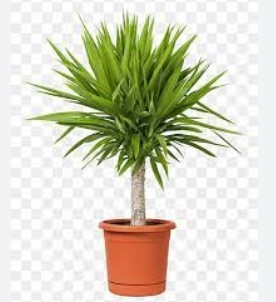
Yucca is a common houseplant with a variety of types to choose from. Yucca plants mimic the appearance of dragon plants with long spiky leaves. Like dragon plants, Yucca plants are also drought-resistant and can withstand dry conditions. Yucca plants have attractive foliage that makes them popular among homeowners and housekeepers. Their leaves can be green or variegated depending on the type of plant you get.
This plant does not require a lot of attention when it comes to watering. You can water your plant when the top third of the soil becomes dry. Be cautious not to overwater your plant as its leaves will rot and the plant will die. A Yucca plant requires a well-draining soil mixture to prevent waterlogging. Consider using perlite and sand to aid drainage.
Your Yucca plant will flourish when exposed to bright indirect sunlight. However, you should be careful not to scorch your plant in direct sunlight. Too little light will lead to slow growth and drooping leaves.
The Yucca plant will thrive under any temperature conditions and moderate humidity levels. The plant is adapted to desert conditions where humidity levels are low. Therefore, your Yucca plant will be just fine under room temperature and low humidity levels.
This plant grows slowly and might not require regular pruning. However, you can get rid of damaged leaves to maintain the plant’s appearance. The Yucca plant is also toxic to animals and humans. Keep it away from pets, horses, and children to prevent accidents.
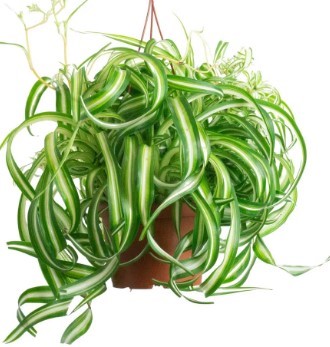
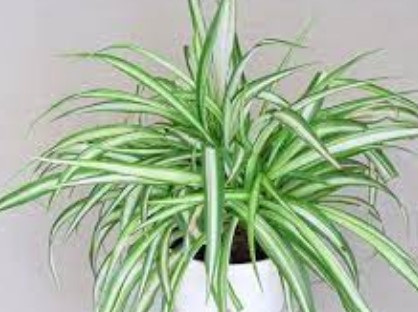

The Spider plant is a common houseplant known for its striking foliage and spider-like appearance. The plant has long slender leaves that are slightly arched and form a rosette. Its leaves are green or variegated depending on the type of plant you select. If you are a beginner, the Spider plant would be an ideal choice due to its low maintenance.
Despite the plant being low-maintenance, it still needs proper care to thrive. The Spider plant requires moderate watering to remain healthy. If the top inch of the soil is dry, you should water your plant. Ensure the soil is moist enough but not wet.
Overwatering will damage the plant’s roots and kill your Spider plant. Use distilled water since the plant’s leaves will become brown when exposed to fluoride or chlorine. The plant requires well-draining soil to grow properly and prevent root rot. Use a pot with draining holes at the bottom to plant your Spider plant.
The plant will do well in moderately alkaline or acidic soil. Your spider plant will flourish when exposed to bright indirect light. Intense light will scorch its foliage. You can place your plant near a shaded window.
The spider plant will thrive in warm humid conditions. You can regularly mist your plant to maintain moderate humidity levels or use a humidity tray. Temperatures below 50 degrees will affect your plant’s health. Regularly prune your spider plant to remove dead leaves.
Jade Tree (Crassula ovata)
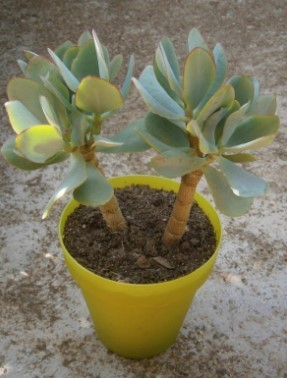
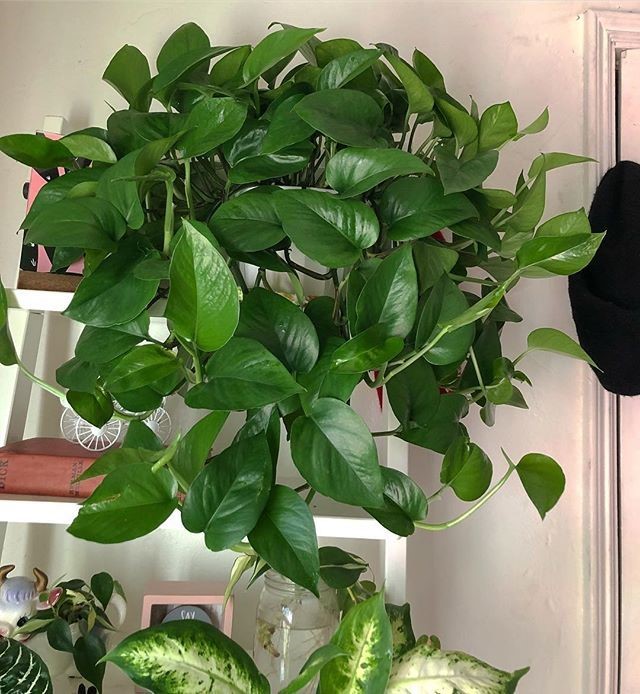
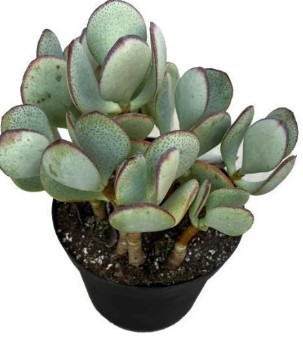
A Jade tree is a common houseplant with green oval-shaped succulent leaves and a thick stem. The plant resembles a small tree and has a striking appearance that makes it stand out. If you are looking for a long-lasting plant, a Jade tree would be the most ideal choice. However, you will need to take good care of your plant for it to thrive.
The Jade plant grows slowly and can reach between 3 and 6 feet. This plant requires bright indirect sunlight to flourish. However, intense sunlight will scorch the plant’s foliage. Too little light on the other hand will make your plant stretchy. You can place your plant in a location with adequate lighting to maintain its health.
This plant requires infrequent watering as it is capable of storing water for a long period. You can water your plant after a week and don’t let the soil completely dry out. Avoid overwatering your Jade plant as its roots will rot and kill the plant. Instead, just ensure the soil is moist enough. Use well-draining soil to prevent waterlogging. The soil should be moderately acidic and neutral.
A Jade plant will thrive under room temperature conditions. However, too low temperatures can affect your plant negatively. Normal household humidity is also fine for the Jade plant. You can propagate a new plant by cutting a mature leaf or stem from your plant.
Take extra caution if you have pets or children in your household. This is because the Jade plant can be toxic to cats, dogs, or even humans when ingested.
Kalanchoe (Kalanchoe spp)
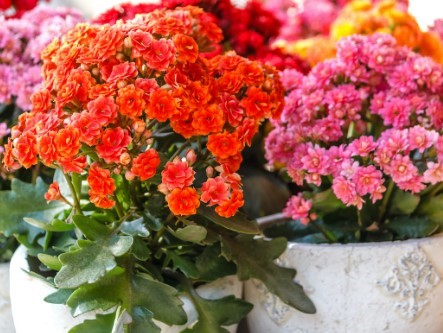
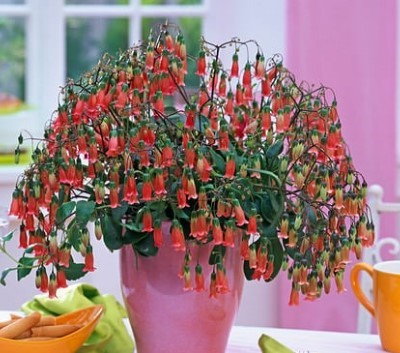
The Kalanchoe plant is a popular succulent indoor plant with distinctive beautiful flowers and glossy green leaves. The plant’s flowers can be available in shades of pink, white, red, or orange. If you want to brighten up your home, a Kalanchoe plant will do the trick.
Taking care of a Kalanchoe plant is relatively easy provided you provide the ideal lighting, watering, temperature, and humidity conditions. If you want your plant to bloom, you should expose it to indirect bright sunlight. Try to avoid direct intense sunlight that can scorch your plant. You can alternate between bright and shaded lighting to prevent scorching.
It is normal to forget about watering your plants with a busy schedule. The Kalanchoe plant will make it easy for you since it doesn’t require frequent watering. Only water the plant when the soil completely dries out.
Avoid overwatering your Kalanchoe as its roots will rot. If you prefer watering your plant from the bottom, ensure it doesn’t sit on the water for too long either. Try to avoid watering the plant’s leaves since they are prone to rot and blemishes.
To thrive, the Kalanchoe plant requires well-draining soil, preferably sandy soil. This type of soil will prevent waterlogging which causes root rot. Your Kalanchoe plant will flourish in room temperature conditions. The plant will also be fine under low humidity levels and you don’t have to mist its leaves. You can prune your plant’s stems to promote more growth and keep it in good shape.
Lucky Bamboo (Dracaena sanderiana)
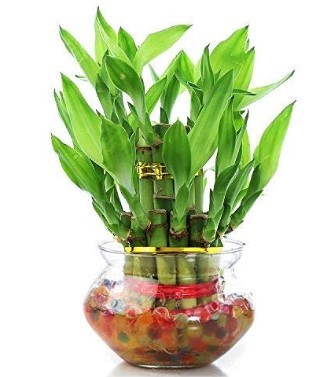
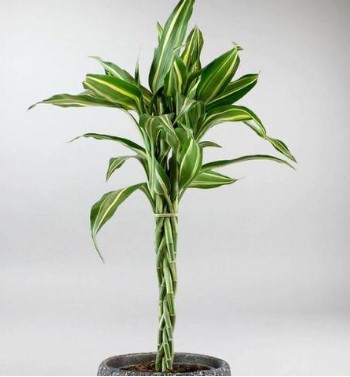
Also known as Dracaena braunii, the Lucky Bamboo is a popular household plant that mimics the look of a bamboo plant. However, the plant is a succulent and is not related to the bamboo plant.
The Lucky Bamboo features long succulent stalks and small green leaves. The plant is believed to bring good luck and fortune to its owner hence its name. the plant is toxic to animals and can be dangerous to your pets.
The lucky bamboo is low maintenance and would be suitable if you are a beginner. This plant requires bright indirect light to thrive. Exposing your Lucky Bamboo to intense direct sunlight will scorch your plant. Instead, place it near a window with adequate lighting and rotate your plant regularly to ensure proper light absorption.
Plant your Lucky Bamboo in well-draining soil rich in organic matter. Alternatively, you can place your plant in a vase with at least an inch of water. This plant requires moderate watering to thrive. Use distilled water since the Lucky Bamboo plant is sensitive to chlorine, fluoride, and other chemicals.
If you prefer using water to grow your bamboo, discard the water every week to prevent foul odors and diseases. Let the water be above the plant’s roots. Clean the vessel regularly to prevent algae formation.
The Lucky Bamboo requires warm temperatures to flourish. The plant will do well in temperatures between 65 and 95 degrees. Keep your Lucky Bamboo away from drafty doors and windows.
Your plant will be okay under moderately humid conditions. You can feed your plant with a drop of liquid fertilizer monthly to promote growth and boost its health. Regularly prune your bamboo to get rid of damaged leaves and maintain its appeal.
Rubber Plant (Ficus elastica)
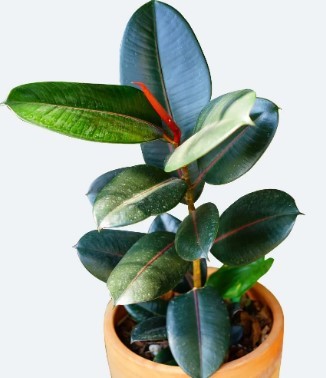
The Rubber plant is a common houseplant with dark green elastic leaves that sprout from a single stalk. However, you can encourage branching by pruning the plant’s leaves. Some rubber plant varieties have attractive variegated leaves.
The Rubber plant grows quickly and would be ideal if you have extra space in your home. The unique plant produces sap used to make rubber, hence its name. This plant will enhance your indoor comfort by cleaning the air.
Taking care of the rubber plant is relatively easy under suitable conditions. This plant will thrive when exposed to bright indirect light. However, too much light will scorch its leaves. You can place your plant near a window with adequate lighting.
When the plant gets inadequate lighting, it begins to become stretchy and lose its rich color and leaves. Provide just enough light for your plant to flourish. Constantly water your Rubber plant. You can wait till the top inch of the soil is dry to water your plant. Overwatering will lead to root rot and eventually kill your plant.
The rubber plant needs well-draining soil to survive. This plant will thrive in acidic soil. you can use a cactus soil mixture to plant your Rubber tree.
The Rubber plant requires warm to moderate temperatures and it can thrive under room temperature conditions. Keep the plant away from drafty windows, doors, and air vents. This plant also requires moderate humidity levels to flourish. When the air becomes too dry, you can mist your plant or use a humidifier to maintain humid conditions.
Since the rubber plant grows quickly, you will need to re-pot your plant annually. Regularly prune your Rubber plant to manage its size and get rid of damaged leaves. The rubber plant is mildly toxic to animals and humans. You should take extra precautions if you have pets or children in your household.
Croton (Codiaeum variegatum)
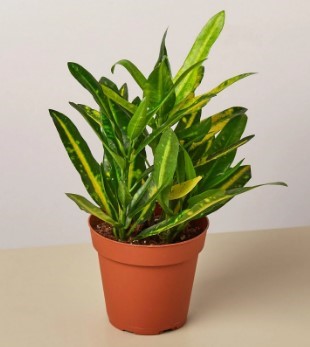
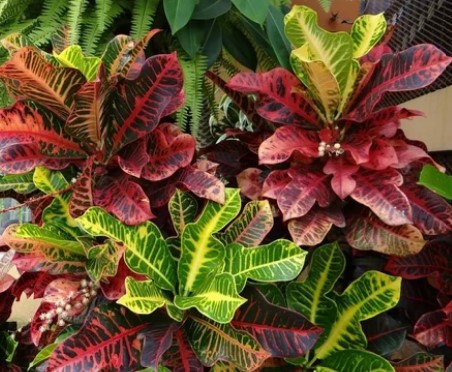
Croton is a popular indoor plant known for its unique and attractive foliage. The plant’s variegated leaves add a pop of color to any space. The colored leaves have red, yellow, orange, and green shades. You can use it as an ornamental plant to complement your décor. This plant can grow up to 10 feet tall outdoors. However, when grown indoors, the plant remains small.
To maintain the plant’s robust colors and lush foliage, you need to take good care of it. Under the right conditions, the Croton plant will blossom and remain healthy. This plant requires bright filtered light to maintain its color. Too much light will burn the plant’s foliage. Without adequate lighting, the variegated leaves will begin to lose color and turn green.
A Croton plant needs regular watering to thrive. Water your plant when the soil is partially dry. You can use your finger to test for moisture. Keep the soil moist but not soggy. Like other plants, your Croton plant will die when overwatered. Plant your Croton in a well-draining soil mixture. Ensure all the water drains from your soil after watering your plant.
This plant needs warm temperatures and moderately high humidity levels to flourish. The Croton plant drops its leaves when the temperature is too low. This plant does not tolerate dry conditions. You can mist your plant daily or use a humidifier to keep humidity levels high. Avoid placing your plant near air vents and drafty windows.
Regularly trim your plant to maintain its appearance. You can re-pot your plant when you notice roots sticking out above the soil’s surface. Take extra precautions when choosing a location for your plant since it is toxic to humans and animals.
Crown of Thorns (Euphorbia milii)
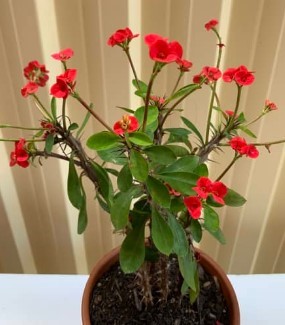
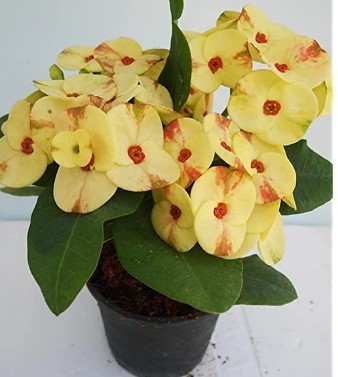
The Crown of Thorns plant is an indoor plant popular for its lush green leaves and small attractive flowers. This succulent plant has a woody stem with thorns that produce a milky sap once broken. The Crown of Thorns gets its name from a popular belief that its stem was used to create Jesus Christ’s crown. This plant is an ideal ornamental plant since it blooms throughout the year with proper care.
The plant’s actual flowers are green and surrounded by white, yellow, red, or white bracts. This plant is easy to maintain and would be ideal for beginners. The Crown of Thorns plant requires bright sunlight to bloom and thrive. You can place your plant near a window that provides the brightest light. Alternatively, you can expose your plant to direct sunlight outdoors for at least 4 hours.
Plant your Crown of Thorns in well-draining soil, preferably a cactus potting mixture. Since this plant is succulent, it doesn’t require frequent watering. You can water your plant when the top inch of the soil is dry. Avoid overwatering the plant to prevent root rot which will kill your plant. When watering from below, don’t let your plant sit in water for a long period.
The Crown of Thorns plant will survive in warm temperature conditions preferably above 65 degrees. Extremely low temperatures will affect blooming and your plant’s leaves might begin to fall off. This plant requires low humidity levels and you don’t need to mist your plant.
You will need to prune your plant often to get rid of damaged stems and leaves. Be careful when handling this plant as the thorns might prick you. The plant also produces milky sap that is toxic upon touch. The sap will irritate your skin and is also toxic to animals when ingested.
Moon cactus (Gymnocalycium mihanovichii)
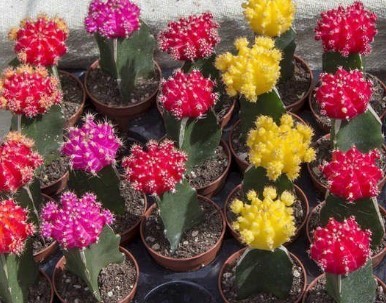
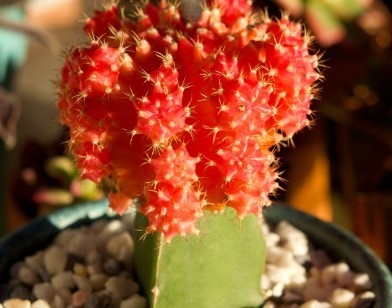
The Moon Cactus is a succulent indoor plant otherwise known as the Star-flowered cactus, Ruby Ball cactus, or Red cap. This plant features a colored ball-like cactus with thorns situated on top of another green cactus.
The top cactus can have different colors including red, yellow, or orange. The brightly colored cactus does not produce chlorophyll and is grafted on the green cactus below to survive.
This plant is ideal for ornamental purposes. The downside of this plant is that it does not survive long. This might be caused by incompatibility between the two cacti. However, this plant will thrive for a certain period with proper care.
The top cactus can survive in low sunlight conditions. The bottom plant, however, requires lots of sunlight to flourish. To strike a balance between the two cacti, provide bright to medium indirect sunlight. When exposed to direct sunlight, the colored cactus will get scorched and start losing its color.
The Moon Cactus is drought tolerant and doesn’t require frequent watering. Water your cactus when the soil dries out. Overwatering the cactus will cause root rot. Plant your Moon Cactus in a well-draining soil mixture to prevent waterlogging. During the winter, water your plant less frequently allowing the soil to dry out before watering it again.
This plant will thrive in moderate temperatures and dry humid conditions since it is a desert plant. However, temperatures below 40 degrees will harm your plant. Since this plant grows slowly, you don’t need to re-pot it regularly. You can re-pot your plant after four years.
Prayer plant (Maranta Leuconeura)
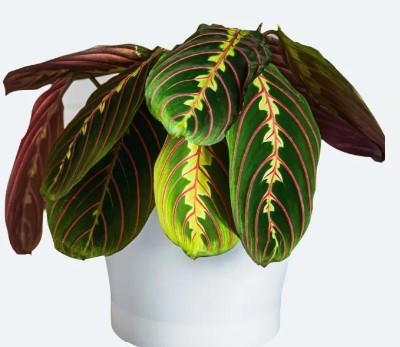
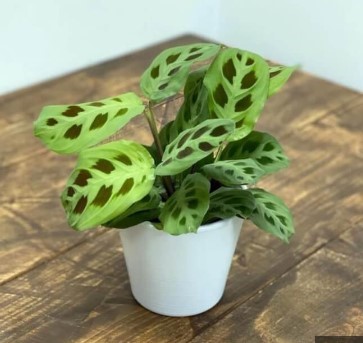
The Prayer Plant is a common houseplant known for its distinctive characteristics. The plant’s leaves close during the night to preserve water and open up during the day to absorb light.
This plant gets its name from how its leaves close up mimicking praying hands. The prayer plant has striking variegated leaves with green, yellow, and red shades. This plant is high-maintenance but worth the effort.
When properly maintained, the Prayer plant can last up to 30 years. This plant requires frequent watering to remain healthy. You should not let the soil completely dry out. Instead, always keep the soil moist but not damp. Overwatering the plant will cause root rot. Water your plant directly on its base to avoid splashing water on its leaves.
Don’t water your plant with cold water. Instead, use water that is at room temperature or moderately warmer. Your water should be free of chemicals like chlorine or fluoride that can damage the Prayer plant. Plant your Prayer plant in well-draining soil to prevent waterlogging. The plant will flourish in acidic soil.
A Prayer plant will thrive when exposed to bright or medium indirect sunlight. Extreme direct sunlight will scorch the plant’s leaves making them lose their beautiful color. You can set your plant near a South-facing window and filter the light using sheers.
The plant will let you know when the conditions are just right. Its leaves won’t open when it’s too dark and they will fade when the light is too bright.
This plant requires moderate temperatures to thrive and room temperature is fine. The plant will begin to shed its leaves when exposed to low temperatures. The Prayer plant requires high humidity levels to thrive. Use a humidifier or a humidity tray to maintain humid conditions.
Bromeliad (Bromeliaceae spp)
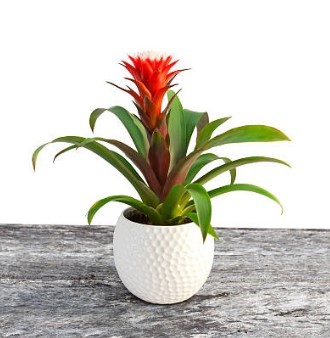
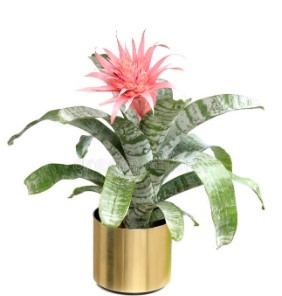
The Bromeliad plant is a popular houseplant with a variety of options to choose from. What makes this plant unique is its attractive bracts available in different shades including purple, yellow, green, orange, red, and yellow. The plant has green spiky leaves that grow to form a rosette. The Bromeliad plant is easy to maintain despite its unique appearance.
This plant requires medium to bright indirect sunlight to thrive. Some Bromeliad varieties will flourish under bright direct sunlight while others prefer shaded light. Providing just the right amount of sunlight will help your plant bloom. Low sunlight levels will make your plant stretchy and appear dark-colored.
A Bromeliad plant requires moderate watering to remain healthy. Regularly water your plant when the soil feels dry. Avoid overwatering your plant to prevent its roots from rotting. Some bromeliads have cup-like structures you can use. Regularly fill the cup with distilled water as the chemicals present in water can negatively affect your plant.
Use well-draining soil to plant your Bromeliad. The soil should be capable of holding just enough moisture to sustain the plant. Bromeliads are tropical plants and thrive in moderately humid conditions.
You can mist your plant regularly or use a humidifier to keep the humidity level up. Bromeliads can survive in moderate temperatures. Extremely low temperatures will affect some varieties of Bromeliads.
Occasionally prune your Bromeliad to maintain its appeal. Get rid of damaged leaves to keep your Bromeliad looking its best.
Chinese Evergreen (Aglaonema commutatum)
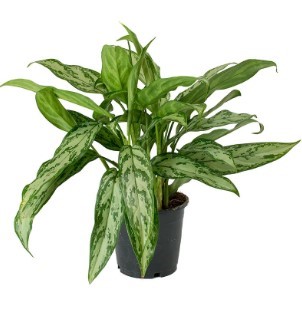

The Chinese Evergreen is a common indoor plant with lush foliage and variegated leaves. This plant is an ideal choice if you want a low-maintenance plant that adds color to your space. The Chinese Evergreen purifies the air and gets rid of toxins.
The plant’s foliage has different colors including red, silver, and green. When fully mature, the Chinese Evergreen plant blooms in the summer. However, when grown indoors, the plant rarely blooms.
Some types of Chinese Evergreen plants like those with variegated leaves require indirect bright sunlight to thrive. Other varieties with darker leaves will flourish in shaded light. However, all types of Chinese Evergreen plants should not be exposed to harsh direct sunlight.
The Chinese Evergreen plant doesn’t require frequent watering to thrive. However, the plant is not drought-tolerant either. Water your plant when the soil is partially dry. Be sure to keep the soil moist but not soggy.
The plant’s roots will rot when you overwater it. Plant your Chinese Evergreen in well-draining soil to prevent root rot. The ideal soil for your plant should be slightly acidic.
This plant will flourish in warm temperatures. Keep the plant away from cold drafts and air vents. The Chinese Evergreen plant needs high humidity levels to remain healthy. Use a humidifier or mist your plant regularly to maintain high humidity levels.
Fiddle Leaf Fig (Ficus Lyrata)

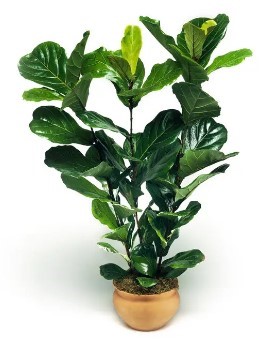
The Fiddle Leaf Fig is a common indoor houseplant with large shiny leaves that look like fiddles. The lush leaves give the plant a distinctive look that will enhance the aesthetic appeal of your home.
This plant would be ideal if you have extra floor space as it can grow up to 6 feet or more. To keep its violin-shaped attractive leaves in great shape, you need to provide the plant with ideal growing conditions.
This plant requires indirect bright light to thrive. You can place your Fiddle Leaf Fig near a window with adequate lighting. Exposing your plant to direct sunlight will scorch its leaves. Inadequate lighting on the other hand will hinder your plant’s growth and make it appear stretchy. Regularly rotate your plant to ensure maximum light absorption.
The Fiddle Leaf Fig plant will grow well in well-draining soil. the plant needs moderate watering to remain healthy. Water your plant when the top inch of the soil feels dry. Try to use distilled water or completely flush the water since the plant is sensitive to chemicals. You just have to ensure the soil is moist but not wet. Soggy soil will cause root rot and kill your plant.
This plant is sensitive to fluctuating temperatures. Use warm water to water your plant. Water that is at room temperature will also be fine. The Fiddle Leaf Fig requires moderately warm temperatures and high humidity levels to flourish. The ideal temperature for your plant is between 65 and 85 degrees. The temperature should not fall under 60 degrees.
Use a humidifier or a tray of pebbles filled with water to maintain high humidity levels. Feed your plant with a fertilizer rich in Nitrogen to keep it healthy. Occasionally prune your Fiddle Leaf Fig to remove damaged leaves and maintain its appeal. You can re-pot a young plant after every year. Dust can collect on the plant’s leaves and affect its health. Constantly dust your plant to expose the leaves to the light.
Parlor Palm (Chamaedorea elegans)
The Parlor Palm is a unique indoor plant with long green leaves and bamboo-like stems. The plant has several stalks that grow in a cluster. This plant complements almost any kind of décor and adds a tropical vibe to your space. The Parlor Palm is quite easy to maintain and would be an ideal choice if you are a beginner.
This plant needs bright filtered light to thrive. When you expose this plant to direct sunlight, its leaves will become burnt. On the other hand, inadequate lighting will slow your plant’s growth. A Northern or Southern-facing window will be an ideal spot for your plant.
The Parlor Palm will thrive with moderate watering. Check to see if the top layer of the soil is dry before watering your plant. The Parlor Palm does not tolerate overwatering and it would be best to keep the soil moist but not soggy. Ensure the water drains from the pot before returning your plant to its location.
Use well-draining soil to minimize the chances of overwatering your plant. When your plant is dry, its leaves will turn yellow.
This plant prefers moderately warm temperatures. A temperature range of 65 to 80 degrees would be ideal. The Parlor Palm will thrive under household humidity levels provided you keep the plant away from drafts and air vents.
When you notice brown leaf tips, you are likely placing your plant near a drafty window or door. Move your plant to a better location and mist it to improve humidity levels. You can re-pot your plant annually with fresh soil. take extra care since the plant’s roots are fragile.
String of pearls (Senecio rowleyanus)
The String of pearls is a succulent vining plant commonly grown indoors. This plant is categorized under the Senecio genus which has a variety of plants you can choose from.
The String of pearls plant has small distinctive leaves that look like peas. This plant looks appealing when planted in hanging baskets, and adds personality to your home. The plant grows quickly and needs regular pruning to maintain its appeal.
With proper care, your String of pearls plant will thrive. This plant requires both direct and indirect sunlight to remain healthy. You can take your plant outdoors during the morning hours and return it indoors in the afternoon when the sun’s rays are too harsh. Choose an ideal spot with adequate lighting indoors, preferably near a South-facing window.
Since the String of pearls is a succulent, it is mildly drought-resistant. Overwatering is more likely to kill your plant than underwatering. The ideal time to water your plant is when the soil is partially dry.
Another sign you should look out for is the plant’s leaves. They will begin to become flat when your plant is underwatered. Keep your plant moist but not overly wet. You can use well-draining and properly aerated soil to prevent waterlogging. A cactus potting mixture would be suitable for your String of pearls plant.
The String of pearls plant thrives in warm temperatures between 70 and 80 degrees and winter temperatures ranging from 55 to 60 degrees. This plant requires low humidity levels to survive.
Place your plant away from humid areas like the bathroom. Occasionally prune your plant to remove dead leaves and damaged stems. You can use stem cuttings to propagate new plants.
Despite the String of pearls being a unique and appealing plant, it is toxic to animals and humans. If you have pets or children in your household, it would be best to place your plant out of their reach.
Choosing an ideal houseplant depends on several factors such as your space, level of maintenance, your needs, and more. Some plants will require a large space to grow while others need a smaller space. Other types of plants will need more care than others. Different houseplants also have varying appearances and you can select one based on your preference and style. If you require more assistance, don’t hesitate to reach out to us today.
